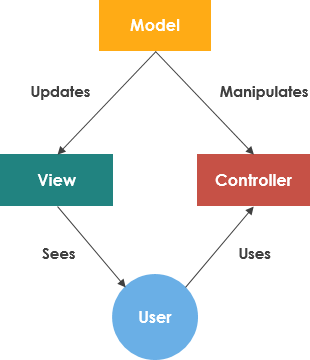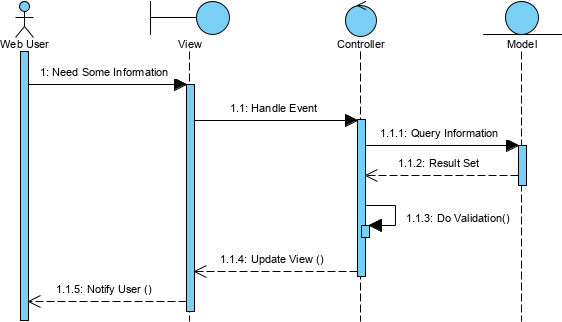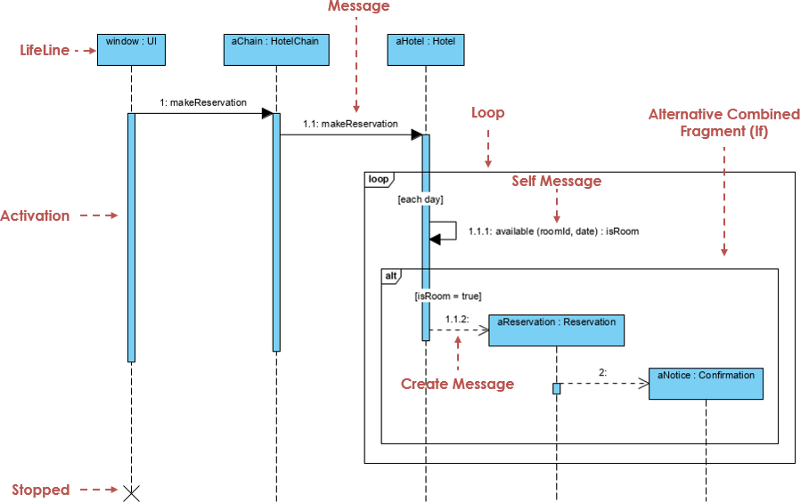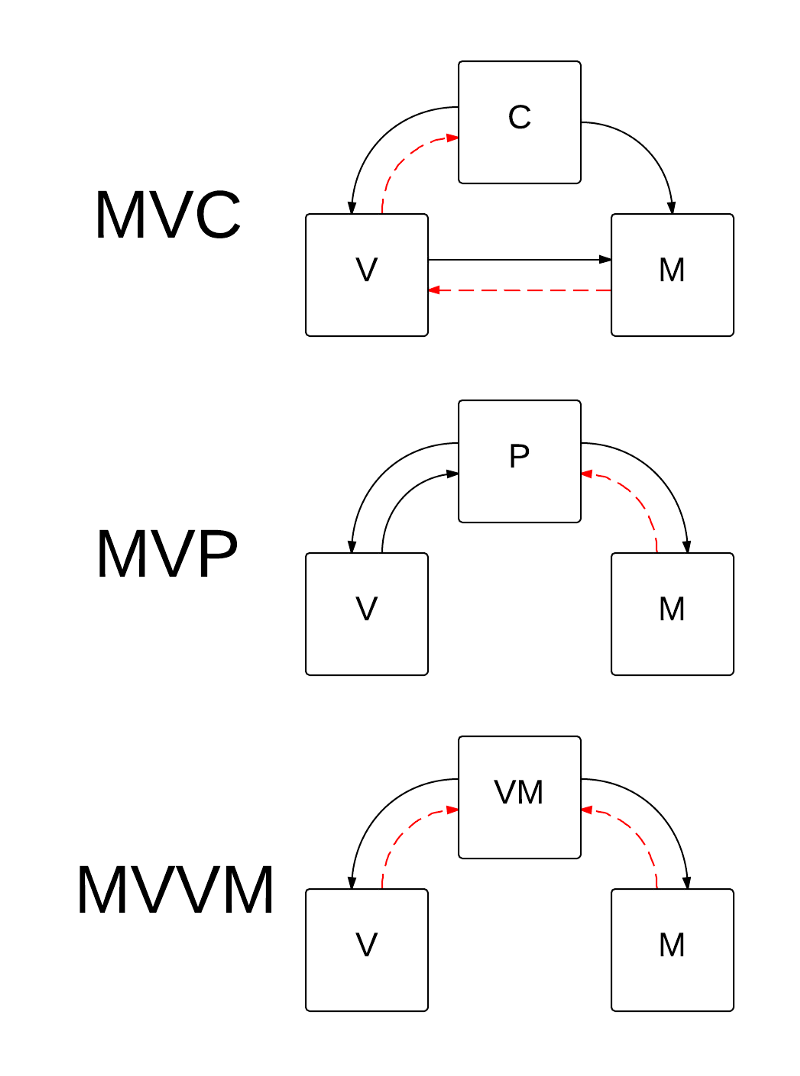Làm thế nào để biểu diễn nó bằng sơ đồ tuần tự UML?
MVC (được biết đến là Mô hình-Giao diện-Điều khiển) là một mẫu trong thiết kế phần mềm thường được sử dụng để triển khai giao diện người dùng, dữ liệu và logic điều khiển. Nó nhấn mạnh sự tách biệt giữa logic kinh doanh và trình bày của phần mềm. Sự “tách biệt mối quan tâm” này cung cấp sự phân chia công việc tốt hơn và bảo trì tốt hơn.
Ba phần của MVC
Ba phần củamẫu thiết kế phần mềm MVCcó thể được mô tả như sau:
- Mô hình: Quản lý dữ liệu và logic kinh doanh. Mô hình chịu trách nhiệm quản lý dữ liệu của ứng dụng. Nó nhận đầu vào từ người dùng từ bộ điều khiển.
- Giao diện: Xử lý bố cục và hiển thị. Giao diện trình bày mô hình theo một định dạng cụ thể.
- Bộ điều khiển: định tuyến các lệnh đến các phần mô hình và giao diện. Bộ điều khiển phản hồi đầu vào của người dùng và thực hiện tương tác với đối tượng mô hình dữ liệu. Bộ điều khiển nhận đầu vào, tùy chọn xác thực đầu vào, và sau đó chuyển đầu vào đến mô hình.

Ví dụ, danh sách mua sắm của chúng ta có thể có các biểu mẫu đầu vào và nút cho phép chúng ta thêm hoặc xóa mục. Những thao tác này cần cập nhật mô hình, vì vậy đầu vào được gửi đến bộ điều khiển, sau đó bộ điều khiển thao tác mô hình theo nhu cầu, và sau đó bộ điều khiển gửi dữ liệu đã cập nhật đến giao diện.
Tuy nhiên, bạn có thể chỉ muốn cập nhật giao diện để hiển thị dữ liệu theo một định dạng khác, ví dụ, thay đổi thứ tự của các mục thành thứ tự chữ cái, hoặc thay đổi giá thấp nhất thành giá cao nhất. Trong trường hợp này, bộ điều khiển có thể xử lý vấn đề này trực tiếp mà không cần cập nhật mô hình.
Ứng dụng của MVC trong phát triển phần mềm
Framework MVC đã được nhiều nhà phát triển phần mềm cũng như các framework và thư viện phần mềm khác sử dụng rộng rãi. Thường được sử dụng cho giao diện người dùng đồ họa trên máy tính để bàn (GUIs), mẫu này đã trở thành một mẫu phổ biến để thiết kế ứng dụng Web.
Các ngôn ngữ lập trình phổ biến có các framework MVC để tạo điều kiện cho việc triển khai các mẫu, chẳng hạn như JavaScript, Python, Ruby, PHP, Java và C# đều có các framework MVC có thể được sử dụng trực tiếp cho phát triển ứng dụng web.
Làm thế nào để biểu diễn nó bằng sơ đồ tuần tự UML?
Trong sơ đồ tuần tự MVC tổng quát dưới đây, nó cho thấy rằng đối tượng giao diện chịu trách nhiệm cho đầu vào và đầu ra của người dùng, tức là, hộp thoại là một ví dụ tốt về giao diện. Đối tượng bộ điều khiển thực hiện logic cho phép các giao dịch được thực hiện trên mô hình. Các đối tượng mô hình đóng gói logic kinh doanh và dữ liệu chi tiết.

Ví dụ sơ đồ tuần tự MVC: Phân đoạn Đặt phòng Khách sạn
Ví dụ sơ đồ tuần tự này cho thấy cách đặt phòng khách sạn có thể được thực hiện. Sơ đồ tuần tự này ghi lại hành vi của một kịch bản đặt phòng khách sạn duy nhất bằng cách hiển thị một số đối tượng ví dụ và các thông điệp được truyền giữa các đối tượng này như được hiển thị trong sơ đồ dưới đây:

Framework MVC liên quan
Một số mẫu thiết kế khác dựa trên MVC, chẳng hạn như MVVM (Mô hình Giao diện Mô hình), MVP (Mô hình Giao diện Trình diễn), và MVW (Mô hình Giao diện)

- Mô hình Quy trình Phần mềm
- Mô hình Quy trình Phần mềm là gì?
- Lập kế hoạch Thích ứng vs Dự đoán: Khi nào Agile? Khi nào Waterfall?
- Chu trình Phát triển Phần mềm là gì?
Thu thập yêu cầu
Phát triển
REST API là gì?
Code First vs Design First trong Cách tiếp cận API
Hướng dẫn Thực hành cho Kỹ thuật Mã
Kiến trúc Hướng dịch vụ (SOA) là gì?
– Framework Swagger vs API Blueprint và Công cụ Tự động hóa
Cách tiếp cận API-First với Framework Swagger
This post is also available in Deutsch, English, Español, فارسی, Français, Bahasa Indonesia, 日本語, Polski, Portuguese, Ру́сский, 简体中文 and 繁體中文.













